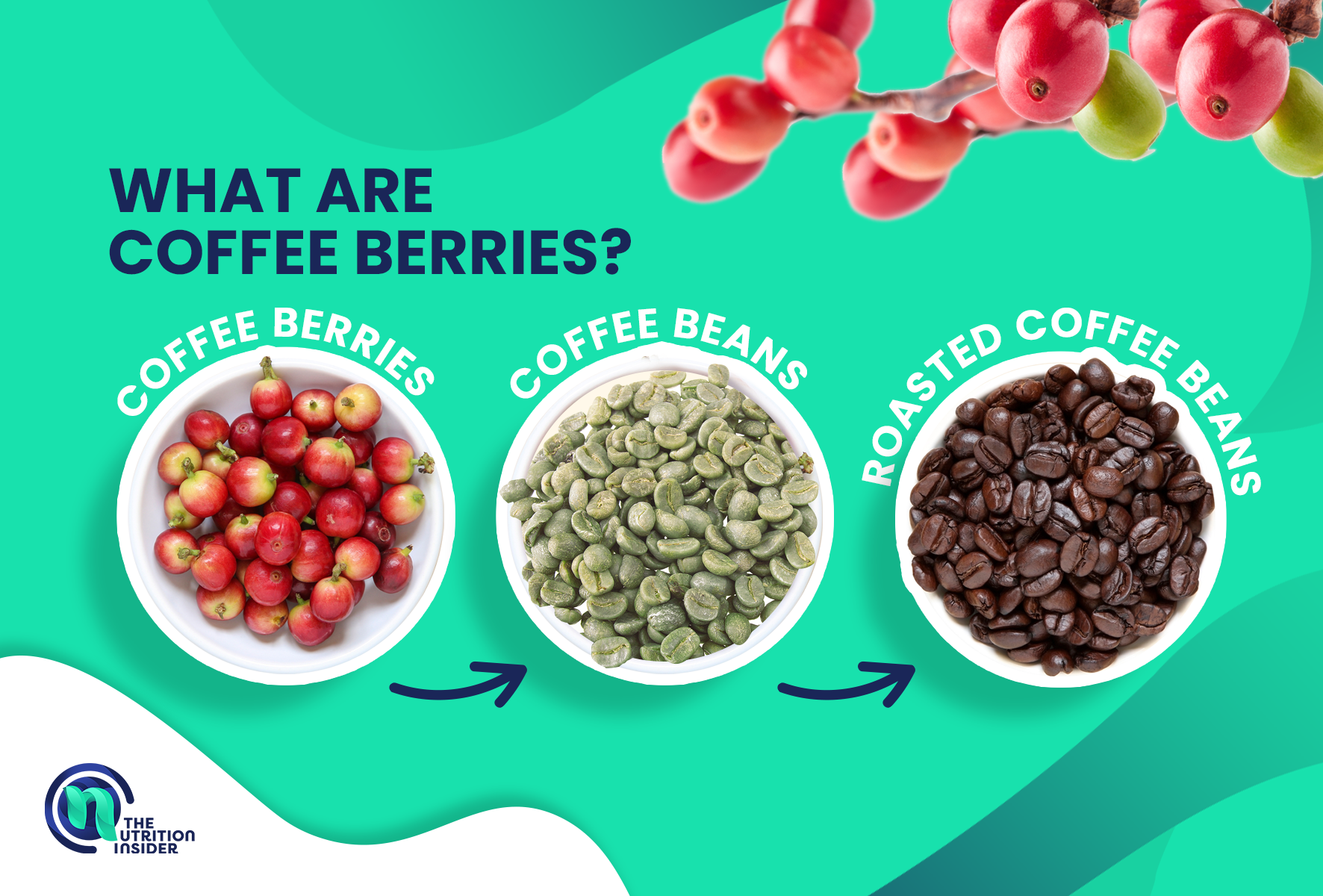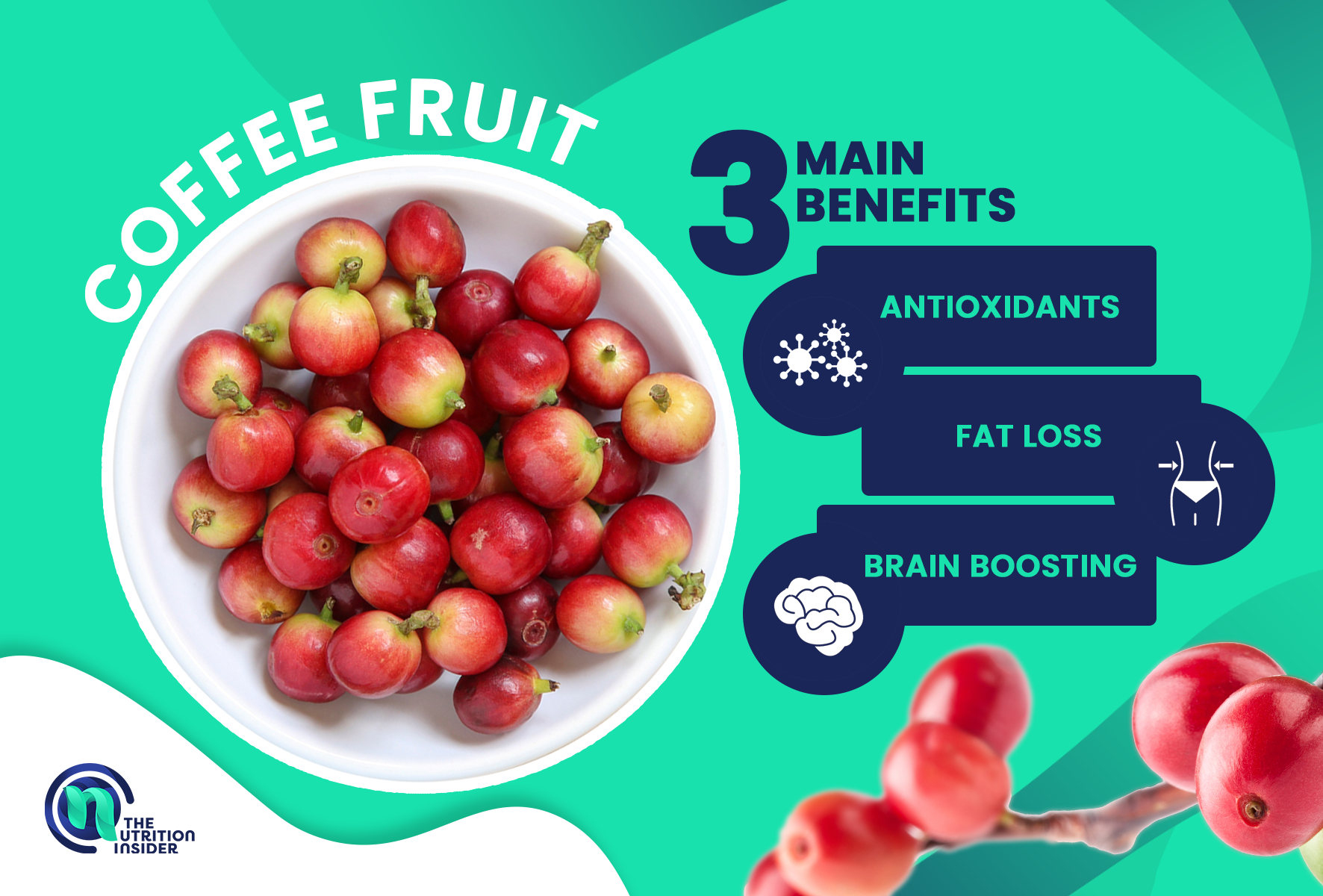Talk to a Registered Dietitian and use INSIDER20 for 20% off!
Talk to a real Dietitian for only $99: Schedule Now
Evidence Based Research To fulfill our commitment to bringing our audience accurate and insightful content, our expert writers and medical reviewers rely on carefully curated research.
Read Our Editorial Policy
Most people are familiar with coffee beans—the enticing smell, the deep brown color, and the anticipation before that first morning sip.
But fewer are familiar with the plant those tasty beans came from—the coffee fruit plant.
Once considered a useless byproduct of coffee harvesting, coffee fruit is now thought to impart various health benefits, including ample antioxidant activity with brain-boosting and fat-fighting potential.
Let’s take a closer look at what coffee fruit is, how it benefits health, and some frequently asked questions about consuming coffee fruit.

Coffee fruit is a small, round stone fruit produced by the coffee berry plant.
As opposed to other stone fruits where we eat the outer flesh portion, the most commonly consumed part of the coffee berry plant is the bean (which should technically be called a coffee seed—but that’s just semantics).
It has some similarities to grapes, both in size and how they grow in bunches.
In its raw form, coffee berry is green, turning deep red, yellow, or purple as it ripens.
Coffee fruit and coffee berry are essentially the same, with coffee berry being a slightly more specific name for the plant.
To add another name to the mix, some call it a coffee cherry, aligning more with its botanical characteristics.
Ripe coffee fruit—or berry or cherry—has a slightly sweet and floral aroma, akin to other reddish fruits.
Coffee berries have been dried and brewed as a tea for centuries, beginning in Ethiopia—the birthplace of our world’s most popular coffee, Coffea Arabica.
When coffee plants began migrating from Africa to Central and South America, the skins of dried coffee berries were referred to as “cascara,” which means “husk,” in Spanish.
Now, you may see the term “cascara” listed as a caffeine source in energy drinks or other beverages—including in lattes at Starbucks.
Although they come from the same part of the plant, the coffee berry is different from the coffee we drink.
The beans you grind in your morning coffee are the roasted seeds found inside the cherry-like coffee fruit.
Although coffee fruit does not taste bad, the coffee cherry skins—the cascara—would ruin the taste of coffee if they were all roasted and brewed together.
Therefore, coffee berries have typically been tossed out by coffee farmers in the past, either putting them back into the earth for fertilization or simply discarded.
Unfortunately, this can create a massive waste problem.
Decaying coffee berries can release harmful mycotoxins into the environment—especially in the warm and tropical climates where coffee is most often grown—leading eco-conscious companies to turn discarded coffee fruit into something useful.
Coffee fruit extract is one way that companies are attempting to make use of the heaps of discarded coffee berries.
As opposed to consuming whole coffee berries, coffee fruit extract is, well, extracted from the fruit, enabling it to be added to supplements and other wellness products.
While the term “superfood” doesn’t have a tightly regulated definition, it’s considered to be a food rich in beneficial compounds like polyphenols, antioxidants, micronutrients, fiber, or healthy fats.
Coffee berry could be considered a superfood because it contains plentiful antioxidants, including caffeine, as well as nutrients like magnesium and riboflavin.

The coffee fruit has many health benefits, including its rich antioxidant content, cognitive-supporting abilities, and fat-fighting action.
Like coffee itself, the coffee berry contains many antioxidants, such as:
Coffee fruit extract that has been multistep extracted has more antioxidants than other processing forms, like freeze-dried, air-dried, or single-step extractions.
Research published in the Journal of Agricultural and Food Chemistry found that the antioxidant activity in whole coffee fruit extracts was 25-fold higher than in coffee berry powders.
Coffee fruit provides several benefits to the brain, primarily because of its antioxidant and caffeine content and ability to boost brain-derived neurotrophic factor (BDNF) levels.
BDNF is a neurogenic compound that helps support the maintenance and growth of new neurons throughout adulthood and protects against cognitive decline.
Research has found that coffee fruit extract increases BDNF levels by an average of 137% compared to baseline levels.
However, the same study also found that chlorogenic acid on its own did not markedly increase BDNF, suggesting that other compounds in whole coffee fruit extract work synergistically to benefit the brain.
Due to its caffeine content and ability to boost BDNF, coffee fruit extract can be considered a nootropic—a compound that enhances cognitive performance in some way.
One randomized controlled trial published in Nutrients found that adults who drank a polyphenol-rich beverage containing coffee berry had robust improvements in mood, energy, and cerebral blood flow—more so than when they drank a blueberry drink.
Chlorogenic acid can also travel to the brain, activating GABA receptors—one of our calming neurotransmitters—to protect the brain from stress.
Coffee berry may also be beneficial to metabolic health and body fat levels.
Studies have found that coffee fruit extract inhibits adipogenesis—the creation of new fat cells—while stimulating lipolysis, or the breakdown of fat for use as energy.
Researchers believe that the combination of caffeine and chlorogenic acid stimulates these lipolytic activities.
In a study with mice eating a high-fat diet, those that supplemented with caffeic acid or chlorogenic acid exhibited markedly lower body weights, fat mass, obesity-related hormones, and blood triglyceride, cholesterol, and insulin levels.
Now that we know more about the compounds that drive coffee fruit’s benefits to health, you may wonder more about how to consume coffee berries.
Let’s take a closer look at some frequently asked questions about eating coffee fruit.
The short answer is: yes, you can eat coffee fruit.
However, you don’t get much yield from eating coffee berry—each berry contains only a little bit of flesh surrounding the seed (AKA bean) inside, making it a less-than fruitful way to consume it.
Also, this thin inner flesh has a thin covering called the mucilage and a slimy film protecting the bean that you’ll have to work around—not too appetizing.
Other ways to consume coffee fruit are via a powder or extract, as seen in many supplements.
For example, Qualia’s Qualia Mind nootropic supplement contains both organic coffee berry and whole coffee fruit extract.
Coffee fruit is most enjoyable when it’s at its ripest stage—some people describe it as a cross between watermelon and raspberry, while others claim coffee fruit has floral flavors like jasmine or hibiscus.
However, when unripe, coffee fruit may have a sour flavor and is not too tasty.
And, no, the fruit will not taste at all like the roasted beans in your favorite coffee beverage.)
Yes, like the beans inside, the coffee berry contains caffeine.
The exact amount of caffeine will vary based on the processing method, but most coffee fruit extract products contain between 5-20mg of caffeine per serving.
For reference, an 8-oz cup of coffee contains about 100mg.
No, coffee fruit is not toxic—even in its raw form.
The coffee berry is entirely edible, although it does have some unappealing qualities, as mentioned earlier.
Coffee berries can be eaten whole, but most people consume it in powdered or extracted form, where it can be added to beverages, smoothies, or taken as a supplement.
Other interesting ways to use coffee berries include making Qishr—a traditional Yemen beverage brewed with ginger and cardamom—or ground into a coffee cherry flour for baked goods.
You can also make Cascara, a common Latin American tea made from dried coffee cherries.
Yes, coffee berries are good for your health, as they contain plentiful antioxidants and compounds that support cognitive and metabolic function.
The combination of caffeine and chlorogenic acid in coffee fruit provides most of the purported benefits.
Jackson PA, Wightman EL, Veasey R, et al. A Randomized, Crossover Study of the Acute Cognitive and Cerebral Blood Flow Effects of Phenolic, Nitrate and Botanical Beverages in Young, Healthy Humans. Nutrients. 2020;12(8):2254. Published 2020 Jul 28. doi:10.3390/nu12082254
Mullen W, Nemzer B, Ou B, et al. The antioxidant and chlorogenic acid profiles of whole coffee fruits are influenced by the extraction procedures. J Agric Food Chem. 2011;59(8):3754-3762. doi:10.1021/jf200122m
Reyes-Izquierdo T, Nemzer B, Shu C, et al. Modulatory effect of coffee fruit extract on plasma levels of brain-derived neurotrophic factor in healthy subjects. Br J Nutr. 2013;110(3):420-425. doi:10.1017/S0007114512005338